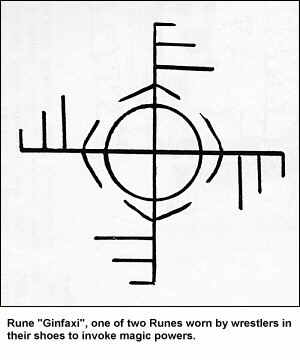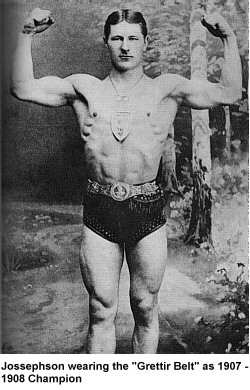The Gripping History of Glima
Journal of Western Martial Art
January 2000
Pete Kautz
Glima translates literally as "The Game of Joy", and is an art roughly 1100 years
old. It was brought to Iceland by Viking settlers, and has been practiced
as a folk art ever since. It is mentioned in writing in the "Jonsbok"
law-book in 1325, "Whosoever participates in a contest of friendly wrestling
or hide-tugging does so on his own responsibility". In other words,
"It's your own damn fault if you get hurt!" The term used in the
book to refer to wrestling is "Leikfang". This is an older name for
wrestling. The root word "Fang" meaning "Catching" in the sense of
 gaining control of a person or object. The term can also be used
to refer to holding someone in their arms, the space between the arms,
or wrestling in general, though in the old sagas when they talked of Leikfang
it sounds more like back-hold wrestling than what we see in Glima today
with the low grip. Some of the Leikfang contests described end with
spines being broken from a man being bent backwards.
gaining control of a person or object. The term can also be used
to refer to holding someone in their arms, the space between the arms,
or wrestling in general, though in the old sagas when they talked of Leikfang
it sounds more like back-hold wrestling than what we see in Glima today
with the low grip. Some of the Leikfang contests described end with
spines being broken from a man being bent backwards.
Glima is traditionally practiced outdoors
in appropriate clothing for the weather. In Iceland, one of the reasons
you might have decided to play a few rounds was just to stay warm on a
cold night! These often cold and slippery conditions are part of
what goes into giving Glima its distinct movement. It would be practiced
on the hillsides or in any natural place that gave shelter, and these were
referred to as Glimuholl or literally "Glima Hall".
The basic idea is to grip your opponent
in the proper way, and then force them to touch their torso or any area
above the elbows or knees, to the ground for the best 2 out of 3 falls.
Also, if both of their arms touch the ground, it is a fall. If both
players fall together then
it is called a "brother-fall" and neither player gets the point.
then
it is called a "brother-fall" and neither player gets the point.
Perhaps the most immediately discernible
characteristic of modern Glima is that the participants today wear special
leather belts. These have a main belt around the waist, and separate
belts on the lower thighs of each leg, which are connected to the main
belt with vertical straps. These belts allow a specific grip to be
taken which is wrestled out of - similar to many other traditions around
the world. Last year I saw an exact duplicate picture of a Glima
belt in the "Weekly World News", a paper that also regularly features the
half-human "bat-boy" and photos of Clinton shaking hands with UFO aliens.
They were saying that this belt was developed by the scientists at NASA
as a "Zero-G Sex Device" for experiments on human reproduction while in
orbit! Believe it...or not.
The reason that the belts are still worn
today is that they are symbolic of wearing the heavy pants and jackets
as they did in the past. The belt gives something to grab, and it
is fair to all competitors. It is also important to note just where
the Glima player is grabbing. The left hip and right thigh are both
places where an opponent's sword or dagger would have been kept in the
old days - and so it should be no surprise that this is where you grip
for play. Your left hand grabs his right thigh and your right hand grips
his left hip. From here you start to circle to the right, both circling
around each other, trying to find a weakness.
There were three main ways Glima was played
in the old days. There was formal Glima and Loose Grips wrestling;
and then there was also wrestling for settling a duel - to the death!
In the deadly matches, which would have only been done over the most serious
of offenses, the two men would go into a field with a large, waist-high,
tapered slab of rock - a stone to smash your opponent down on to slay him.
One of these still stands today on a farm in the western part of Iceland.
Let this be a lesson to modern grapplers - look for the "slaying stones"
in urban areas and other places you might have to fight, and let the terrain
magnify the power of your throw!
 In
Loose Grips, the formal rules of play are not followed to the letter and
a player is allowed to "cheat" in that sense, since Loose Grips is not
considered "correct wrestling" (by the rules of Glima). The initial
grip is different than the one used in the formal game, and follows after
the familiar "collar-and-elbow" style seen the world over. The match
doesn't stop when one player touches the ground, and sacrifice throws and
other tactics that might be used that are specifically referred to as being
"illegal" in Formal Glima are used. One such throw seen in Loose
Grips is the Somersault throw (similar to Tomo-Nage). This is fine
for loose-grips play, but in technical Glima you would be touching your
own body to the ground, so you would lose the fall! In the case where
both players fall to the ground in Loose Grips, whomever stands up first
is declared the winner. There are at least 27 traditional techniques
used in Loose Grips only.
In
Loose Grips, the formal rules of play are not followed to the letter and
a player is allowed to "cheat" in that sense, since Loose Grips is not
considered "correct wrestling" (by the rules of Glima). The initial
grip is different than the one used in the formal game, and follows after
the familiar "collar-and-elbow" style seen the world over. The match
doesn't stop when one player touches the ground, and sacrifice throws and
other tactics that might be used that are specifically referred to as being
"illegal" in Formal Glima are used. One such throw seen in Loose
Grips is the Somersault throw (similar to Tomo-Nage). This is fine
for loose-grips play, but in technical Glima you would be touching your
own body to the ground, so you would lose the fall! In the case where
both players fall to the ground in Loose Grips, whomever stands up first
is declared the winner. There are at least 27 traditional techniques
used in Loose Grips only.
In the modern game, players wear special
shoes in addition to the belts previously described. The belts were
introduced to play in 1905, and from this time on they were gripped instead
of the opponents trousers. The next year would see the introduction
of the highest honor in Glima to be awarded - the Grettir Belt, which has
been given each year to the greatest Glima player in Iceland, who wins
the Icelandic Glima Championship. It is named after a character from
one of the Norse sagas who was fantastically strong and a master of wrestling
- it is like having the Hercules Belt!
The game was further formalized when the
Icelandic Sports Federation published official rules for competition in
1916. In the modern day, Formal Glima is characterized by 4 key points
and 8 basic tricks (bragd) using the legs, hips, and feet to throw with.
4 Key Points, without which you don't have true, formal Glima:
- The fixed grip on the opponent's waistband and outside of their leg
- The upright position of the contestants
- The circular movement of the wrestlers, called Stigandi (Treading)
- Distinctive throws done with the legs, hips, and feet
8 Basic Tricks, each of course has variations:
- The Outside Stroke
- The inside-click, the cross-click & back-heel
- The twist over the knee, the outside hipe
- The hook
- The cross buttock
- The inside-hipe
- The cross-buttock aloft
- The full or half buttock
Journal of Western Martial Art
About the author: Mr. Kautz has been training in both Eastern and Western
combative disciplines for twenty years, including Arnis Black Belt (1991),
Kung Fu Black Sash (1993), Tai Chi Chuan and Pa Kua Chang Instructor recognition.
In the Western arts, he has focused on the analysis and development of
Medieval knife techniques and grappling based on the works of Dei Liberi,
Talhoffer, Marozzo, and others. Pete has also written a book on this subject
entitled "Mani Contra il Courtilo - Hands Against the Knife" which covers
much of the research he has conducted on Marozzo.
 gaining control of a person or object. The term can also be used
to refer to holding someone in their arms, the space between the arms,
or wrestling in general, though in the old sagas when they talked of Leikfang
it sounds more like back-hold wrestling than what we see in Glima today
with the low grip. Some of the Leikfang contests described end with
spines being broken from a man being bent backwards.
gaining control of a person or object. The term can also be used
to refer to holding someone in their arms, the space between the arms,
or wrestling in general, though in the old sagas when they talked of Leikfang
it sounds more like back-hold wrestling than what we see in Glima today
with the low grip. Some of the Leikfang contests described end with
spines being broken from a man being bent backwards. then
it is called a "brother-fall" and neither player gets the point.
then
it is called a "brother-fall" and neither player gets the point. In
Loose Grips, the formal rules of play are not followed to the letter and
a player is allowed to "cheat" in that sense, since Loose Grips is not
considered "correct wrestling" (by the rules of Glima). The initial
grip is different than the one used in the formal game, and follows after
the familiar "collar-and-elbow" style seen the world over. The match
doesn't stop when one player touches the ground, and sacrifice throws and
other tactics that might be used that are specifically referred to as being
"illegal" in Formal Glima are used. One such throw seen in Loose
Grips is the Somersault throw (similar to Tomo-Nage). This is fine
for loose-grips play, but in technical Glima you would be touching your
own body to the ground, so you would lose the fall! In the case where
both players fall to the ground in Loose Grips, whomever stands up first
is declared the winner. There are at least 27 traditional techniques
used in Loose Grips only.
In
Loose Grips, the formal rules of play are not followed to the letter and
a player is allowed to "cheat" in that sense, since Loose Grips is not
considered "correct wrestling" (by the rules of Glima). The initial
grip is different than the one used in the formal game, and follows after
the familiar "collar-and-elbow" style seen the world over. The match
doesn't stop when one player touches the ground, and sacrifice throws and
other tactics that might be used that are specifically referred to as being
"illegal" in Formal Glima are used. One such throw seen in Loose
Grips is the Somersault throw (similar to Tomo-Nage). This is fine
for loose-grips play, but in technical Glima you would be touching your
own body to the ground, so you would lose the fall! In the case where
both players fall to the ground in Loose Grips, whomever stands up first
is declared the winner. There are at least 27 traditional techniques
used in Loose Grips only.